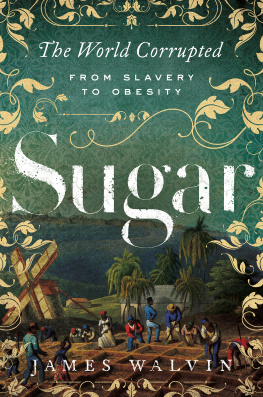PENGUIN BOOKS
SWEETNESS AND POWER
Sidney W. Mintz is professor of anthropology at Johns Hopkins University, whose faculty he joined after teaching for two decades at Yale. He is the author of Worker in the Cane, Caribbean Transformations, and Tasting Food, Tasting Freedom: Excursions into Eating, Culture, and the Past, co-author of The People of Puerto Rico, and editor of Slavery, Colonialism and Racism.
I do not know if coffee and sugar are essential to the happiness of Europe, but I know well that these two products have accounted for the unhappiness of two great regions of the world: America has been depopulated so as to have land on which to plant them; Africa has been depopulated so as to have the people to cultivate them.
from Volume 1 of J. H. Bernardin de Saint Pierres
Voyage to Isle de France, Isle de Bourbon,
The Cape of Good Hope... With New Observations on Nature and Mankind by an Officer of the King (1773)
This engraving by William Blake, Europe Supported by Africa and America, was commissioned by J. G. Stedman for the finis page of his book Narrative of a five years expedition, against the Revolted Negroes of Surinam
(London: J. Johnson & J. Edwards, 1796)
(Photo courtesy of Richard and Sally Price)
PENGUIN BOOKS
An imprint of Penguin Random House LLC
375 Hudson Street
New York, New York 10014
penguin.com
First published in the United States of America by Viking Penguin, Inc. an imprint of Penguin Random House LLC, 1985
Published in Penguin Books 1986
Copyright 1985 by Sidney W. Mintz
Penguin supports copyright. Copyright fuels creativity, encourages diverse voices, promotes free speech, and creates a vibrant culture. Thank you for buying an authorized edition of this book and for complying with copyright laws by not reproducing, scanning, or distributing any part of it in any form without permission. You are supporting writers and allowing Penguin to continue to publish books for every reader.
A portion of this book appeared originally in Boston Review.
Ebook ISBN 9781101666647
THE LIBRARY OF CONGRESS HAS CATALOG ED THE HARDCOVER EDI TION AS FOLLOWS:
Mintz, Sidney Wilfred, 1922
Sweetness and power.
Bibliography: p.
Includes index.
1. SugarSocial aspectsHistory. 2. Sugar tradeSocial aspectsHistory. I. Title.
GT2869.M56 1986 394.1'2 86781
ISBN 9780140092332
Version_1
For Jackie
with love and gratitude
Acknowledgments
T his book has a lengthy past. I began collecting data for it many years ago, without even knowing it; then writing it took time, too. I began to draft it in 1978, while enjoying a National Endowment for the Humanities fellowship. I thank the Department of Anthropology of the University of Pennsylvania, which bestowed on me a visiting title during the year I spent in Philadelphia; and Professor William H. Davenport, who generously afforded me, in addition to his company, half of his precious office space to use as my own.
During the spring of 1978, thanks to the hospitality of the Department of Anthropology of Princeton University, the Christian Gauss Lecture Committee, and their respective chairmen, Professor James Fernandez and Professor Joseph Frank, I was able to try out some of my ideas on thoughtful audiences. Insightful critics, including Professors Natalie Z. Davis, Stanley Stein, and Victor Brombert, did what they could to help me with their queries.
The summers of 1980 and 1981 were spent at that mecca of scholarship, the British Library. The Wenner-Gren Foundation and its director of research, Lita Osmundsen, made it possible for me to go to England during one of those summers. A research grant, provided through the good offices of a great Hopkins dean, the late Dr. George Owen, financed the other.
Of special importance were the people who helped me to find materials, copied and kept in order citations, documents, and references, and typed manuscript revisions. I am particularly grateful to Elise LeCompte, who surely worked as hard on the book as I did, before emigrating to graduate school. Marge Collignon typed the final draft with skill and celerity. Dr. Susan Rosales Nelson worked swiftly and efficiently in preparing the index.
To the librarians who showed me unfailing kindness at the Van Pelt Library (University of Pennsylvania), the British Library, the Wellcome Institute of Medicine Library, the Firestone Library (Princeton University), the Enoch Pratt Free Public Library of Baltimore, and, above all, the Milton S. Eisenhower Library (The Johns Hopkins University), I owe more than I can say. A special salute to the staff of the Interlibrary Loan Department of the Eisenhower Library, whose industry, dedication, and efficiency are unmatched.
Many good friends read and criticized portions of the manuscript at different points in its preparation. Among them I must mention my colleague Professor Ashraf Ghani, as well as Dr. Sidney Cantor, Professor Frederick Damon, Professor Stanley Engerman, Dr. Scott Guggenheim, Dr. Hans Medick, and Professor Richard Price. Rich and detailed critical commentary on the entire manuscript came from Mr. Gerald Hagelberg, Professor Carol Heim, Mr. Keith McClelland, Professor Rebecca J. Scott, Professor Kenneth Sharpe, and Dr. William C. Sturtevant. I have not been able to deal adequately with all of their criticisms and suggestions, but their help improved the text more than they will probably recognize. Special enlightenment was volunteered by a veteran member of the sugar tramp fraternity, Mr. George Greenwood, for which I am most grateful. I also want to thank the members of my departmentfaculty, staff, and students. Their encouragement and support during our first decade together have given new meaning to the word collegiality. My editor, Elisabeth Sifton, awed me with her skill and fired me with her enthusiasm; I thank her warmly.
If anyone suffered more with this book than I, it was my spouse, Jacqueline, to whom it is dedicated with all of my love and gratitudea late present for our twentieth anniversary.
Sidney W. Mintz
Contents
List of Illustrations
Frontispiece
: Europe Supported by Africa and America, by William Blake (1796)
Photographs
: A uniformed slave cutting sugar cane (1722)
: A late-nineteenth-century depiction of tropical plants, including imagined sugar cane
: An early-nineteenth-century slave gang hoeing and planting canes in Antigua
: A sixteenth-century sugar plantation in Spanish Santo Domingo
: A seventeenth-century sugar mill in the French Antilles
: Nineteenth-century sugar boiling-houses
: A sugar mill in operation today
: The Sugar Hogshead, by E. T. Parris (1846)
: Nineteenth-century French desserts
: Miniature sugar figures
: Mexican funereal confections
: Sugar mold commemorating the silver jubilee of George V of Great Britain (1935)
: Model of the British royal state coach (1977)
: Model of the cathedral at Amiens (2 views) (1977)
: Model of a French sailing ship













